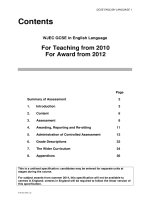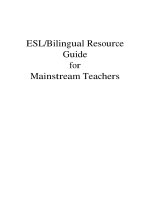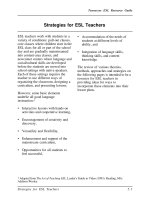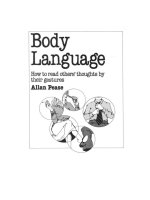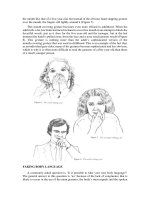body language for competent teachers
Bạn đang xem bản rút gọn của tài liệu. Xem và tải ngay bản đầy đủ của tài liệu tại đây (2.05 MB, 209 trang )
Body Language for Competent Teachers
Nonverbal skills are invaluable for teachers in ‘getting the message across’ to classes and
understanding the messages pupils are sending—messages of interest or messages of
confrontation, which are first expressed non-verbally. With increasing interest in
classroom competence, teachers need to understand the use of gesture, posture, facial
expression and tone of voice. These have become especially important for effective
teachers in a climate where respect has to be earned rather than coming automatically
with the job.
Each chapter of the book has training exercises related to its theme for the new teacher;
answers are provided at the end of each chapter. The last chapter is addressed to staff
responsible for staff training and development, especially in the school context, and
includes suggestions for half- and whole-day courses.
Sean Neill has been carrying out research on non-verbal communication at the
University of Warwick over the last ten years, and has taught, and published numerous
research papers and an academic book, Classroom Nonverbal Communication.
Chris Caswell is a member of the Senior Management Team at Myton School,
Warwick and has wide-ranging teaching experience. He has taught school-based courses
on classroom non-verbal skills at Myton and other schools, and related courses in other
institutions, as well as counselling many inexperienced colleagues.
Body Language for Competent
Teachers
Sean Neill and Chris Caswell
London and New York
First published 1993
by Routledge
11 New Fetter Lane, London EC4P 4EE
This edition published in the Taylor & Francis e-Library, 2005.
“To purchase your own copy of this or any of Taylor & Francis or
Routledge's collection of thousands of eBooks please go to
www.eBookstore.tandf.co.uk.”
Simultaneously published in the USA and Canada
by Routledge
29 West 35th Street, New York, NY 10001
© 1993 Sean Neill and Chris Caswell
Permission is hereby granted to reproduce
the materials in this book for non-commercial
classroom and other educational use.
A catalogue reference for this title is available from the British Library
ISBN 0-203-39269-8 Master e-book ISBN
ISBN 0-203-39551-4 Adobe e-Reader Format
ISBN 0-415-06660-3 (Print Edition)
Library of Congress Cataloging in Publication Data
Neill, S. R. St. J. (Sean Rupert St. John), 1945
Body language for competent teachers / Sean Neill and Chris
Caswell.
p. cm.
Includes bibliographical references (p.) and indexes.
ISBN 0-415-06660-3
1. Nonverbal communication in education—Great Britain—Problems,
exercises, etc. 2. Teachers—Training of—Great Britain—Problems.
exercises, etc. 3. Interaction analysis in education. I. Caswell,
Chris, 1950- . II. Title.
LB1033.5.N44 1992
371.1′22—dc20 92–24744
CIP
For our children
Clare, Richard, Riki, Rupert, Samantha and Suzannah
and their teachers
Celia and Liz
Contents
1
2
3
4
5
6
7
8
9
10
Acknowledgements
General note
Preface—who this book is for
viii
x
xii
Introduction
What is non-verbal communication?
Stage directions and props
Pupil behaviour and deviancy
The meaning of pupils’ non-verbal signals
Getting attention
Conveying enthusiasm
Confrontations; or the Empire Strikes Back
Relationships with individual children
Implications for trainers
1
9
25
39
50
69
89
117
142
167
References
Further reading
Author index
Subject index
179
182
184
187
Acknowledgements
Much of the research on which this book is based was funded by the Nuffield
Foundation. We are grateful to the colleagues who have assisted us, especially John
Robertson, and to our families for their forbearance over many years. Our greatest debt is
to the teachers and children from whom we have learnt so much, and especially to those
who have participated in our research, at no direct benefit to themselves, but, we hope, to
the benefit of those who follow them.
General note
We have generally referred to the teacher as ‘you’ in the text; for clarity we refer to
individual children as ‘he’ and teachers as ‘she’, except when dealing with particular
individuals or the small amount of behaviour specific to one sex. In the great majority of
cases, teacher and pupil behaviour relates to their roles irrespective of sex.
As discussed in Chapter 2, there is little research evidence in the United Kingdom on
ethnic differences in classroom non-verbal communication. Unshaded line drawings have
been used for clarity, including in illustrations based on photographs or recordings of
blacks. To preserve anonymity, sex and appearance have been changed, except where
they are critical to the points made from an illustration.
Preface—who this book is for
This book is intended for new classroom teachers, including licensed and articled
teachers, and those who advise and train them. The section on initial encounters with
groups will be valuable to many others who have the same need as teachers to show
authority, such as youth group workers and playground supervisors. Workers with adults
and youth trainers, as well as teachers, have to arouse the interest of their listeners and
communicate interest in them and their efforts. Many of the techniques are also valuable
to those dealing with groups of adults—though hopef ully they will not need our advice
on dealing with disruption. We have addressed the main text to ‘you’ as the
inexperienced practitioner.
Each section of the book includes exercises which readers can use on a
selfinstructional basis. At the end of the book we include guidance for people running
courses for colleagues, especially on how they can phase the exercises and on collecting
and using material for more advanced work in in-service and initial courses. Some
techniques, such as videotaping course participants, are potentially challenging and
distressing for those involved, especially those who are already having difficulties and
who could potentially benefit most from such a course. As a course leader you must
therefore tread carefully. Our advice on course arrangement is based on experience of
what engages the interest and involvement of participants, without stressing them unduly.
We can’t guarantee that this will work in your situation, but it should!
Our ideas and conclusions are based on research evidence as well as practical
experience. Much of the original research is published in academic journals which are
only available in specialist libraries, but there are several books available (including Sean
Neill’s Classroom Nonverbal Communication) which give more detailed surveys of this
research. If you want to follow up a particular point, the books listed under ‘Further
Reading’ have full reference lists which will allow you to follow up topics in more detail.
Except in a few cases where a topic is only covered in journal articles (for example, the
assessments of what kinds of training course on classroom non-verbal research work,
covered in Chapter 10) we refer as far as possible to books which are fairly readily
available.
TRAINING—AND SELF-TRAINING—MATERIALS
At the end of each chapter we include exercises and discussion topics. So why put
exercises in this book? Well, they are there for three reasons. Firstly they should help you
to clarify some of the issues that we raise during the chapters by applying them to a
specific set of images or circumstances—a sort of ‘test yourself’ exercise! The value of
active learning applies in this area too. Secondly, they will allow you to apply your
existing knowledge (and there will be a lot of it!) to given situations, thereby
accentuating the principle that teachers can and do use non-verbal strategies as part of
their coping armoury. Thirdly, they should allow you to define and develop strategies on
an accumulating basis, by applying what you have learned so far to easily understood and
recognisable situations. Simply stated, the exercises should, collectively, help you to
develop your knowledge and understanding of non-verbal communication and suggest
how you can apply it to actual classroom situations.
In order to achieve this our exercises follow two distinct formats—pictorial and
descriptive—each requiring a different response from you.
Firstly, there are ‘Pictorial Exercises’: ‘What are these images saying?’ Here we have
used drawings to illustrate particular non-verbal signals or patterns of behaviour.
Each chapter will have a number of these exercises, requiring you to provide your own
definitions as to what is probably happening, or what you think the image is saying. To
help, we have provided our own definition or explanation for each exercise at the end of
the chapter (working, of course, from the privileged position of knowing the situation
from whence the images were taken!).
You should not be unduly concerned if your explanations vary slightly from ours, as
images taken out of context can be ambiguous and misleading. Indeed, this is precisely
the point we shall make repeatedly about how non-verbal signals are used: their
ambiguity allows messages to be conveyed without either sender or receiver having to
acknowledge them explicitly. This is most obvious when pupils want to be disruptive
without overtly challenging you, or when you use ironic non-verbal signals to qualify an
apparently innocuous verbal statement; but non-verbal signals can also have a more
positive value. You can convey enthusiasm or praise non-verbally to pupils, who might
reject it, if you gave it verbally, because of pressures from their peers.
The real value of these pictorial exercises lies in the process of attempting to define the
meaning behind them and, by doing so, becoming more familiar with the potential of
such signals. We hope to encourage you to watch your class in a more specific and
structured way and to develop, over a period of time, a sort of ‘thesaurus’ or index of
behaviours from which you will be able to predict more accurately the intention of the
individuals within your class.
Secondly, there are ‘Descriptive Exercises’: ‘What are these situations saying?’ Here
we are exploring non-verbal features in actual classroom situations (taken from our own
experience) where even a series of drawn images would be unable to convey the full
nature and complexity of the problem. We hope that the circumstances described in these
exercises will be reasonably familiar to you, but if not, it is perfectly acceptable, indeed
desirable, for you to modify the situations to fit individuals and circumstances known to
and remembered by you from your teaching career, training or even from your own
school-days!
Within these situations you are asked to consider what the non-verbal dimensions may
be; what you can recognise and what is probably being conveyed. Again, we hope to
encourage you to focus on those non-verbal behaviours that you already recognise and
use, albeit often subconsciously, and to become more aware of those strategies and
behaviours that form part of your pupils’ repertoire.
These descriptive exercises may be particularly useful when used as part of group or
pair situations, where you will be able to share ideas and may be more inclined to role-
play or mimic particular stances or gestures. It takes courage to do this, but it is the
quickest way of reminding yourself just how powerful non-verbal communication can be.
Where appropriate, many chapters will include comments on a number of common
concerns associated with the chapter content. These will be set out in such a way as to
outline the concern and suggest possible solutions. Of course there will be readers who
will say, ‘Well that won’t work here!’, or, ‘What, with my class? They must be joking!’
Clearly, any solution must suit the circumstances in which it is to apply (we explore this
point more fully in the next section); we are acutely aware of the limitations of providing
such ‘words of wisdom’. However, finding a beginning may be half the solution and our
thoughts may serve to trigger a reaction or discussion, which you and your colleagues can
tailor to fit your own circumstances.
The exercises throughout the book are there to assist in your understanding of the
concepts under discussion, but don’t let them become intimidating. For many readers it
may be sufficient simply to read through, and perhaps come back to the exercises later.
Some may feel that the exercises (especially the ‘Descriptive Exercises’) are better suited
to a whole-school INSET topic, where teachers have the opportunity to discuss the
exercises, pooling their thoughts and experience. Whatever your response is, it should be
remembered that no exercise, no matter how intricate or cleverly constructed, can replace
the ‘real life’ experience that it is attempting to replicate. Your experiences are as valid as
any, and your knowledge of non-verbal communication probably far more advanced than
you have realised. If we can help you to focus your knowledge in such a way as to allow
you to maintain an effective working relationship with and between the pupils in your
charge, and still come away with some loose change in the sanity purse, we shall be
pleased.
WILL IT WORK?
The training materials raise the question, ‘Will it work?’ To this the answer must be
‘Usually’. Perhaps a little more detail, and a more theoretical approach to what we mean
by ‘usually’, will help.
Forecasting what will work in a classroom situation has much in common with
forecasting the weather. Despite the fact that weather is controlled by well-known
physical processes, it is virtually impossible to predict exactly what it will be doing more
than a few days ahead. This is because it is impossible to detect all the influences which
are at work on a particular weather system, and the influence of the factors which are
missed builds up rapidly. As a result, two situations which may appear to be identical can
develop in different directions. However, weather is not completely unpredictable; some
types of weather system are more stable and predictable than others, and we can make
overall predictions even if we cannot predict in fine detail. Thus we cannot predict
whether it will rain or not on Midsummer Day two years hence, but we can be sure it will
not freeze. (Technically, weather can be described by chaos theory (the mathematical
variety)—chaos theory, in all its forms, is only too familiar to most teachers.)
In the same way, we cannot be sure that a given behavioural tactic will invariably be
successful in the classroom; you may have missed what another member of the class was
doing previously; there may be school or home circumstances which influence pupils’
reactions; you may in fact not be sending out the signals you think you are sending.
However, it is most unlikely, for instance, that a flat, monotonous delivery will arouse the
interest of an unenthusiastic class, or that a diffident approach will discipline them. The
very fact that the signals we are dealing with have developed for purposes of
communication means that most children will react to them in similar ways on the basis
of their previous experience. In the same way, verbal commands will usually, but not
always, have the expected effect. If you say ‘Sit down’ the class may not; however, they
are more likely to than if you had said, ‘Leave the room’.
Furthermore, non-verbal signals are more powerful in conveying feelings than speech
because most recipients are less aware of them. If you overtly tell a class that the subject
you are dealing with is really exciting, or that you intend to deal firmly with any
indiscipline, the explicit message may give the more cynical members of the class a clear
target to aim at. If you convey enthusiasm or firmness non-verbally, your audience
extracts the message from your behaviour subliminally. Since they have derived the
message themselves without being aware of having done so, they are less likely to be able
to challenge it.
SUMMARY
The main text of the book is addressed to inexperienced teachers, with teacher trainers,
especially at a school level, and other professionals who have similar communication
problems as secondary audiences. The final chapter is primarily addressed to trainers.
Though the book is research-based, its aim is practical training.
At the end of each chapter we will include exercises of two types. The first are for
practitioners reading the book on their own; they are short exercises to test existing
knowledge and what has been learnt from the chapter. The second set include
descriptions of activity sequences which can be done independently or as a group and
used as points for discussion. Most of these problems derive from crises which
inexperienced teachers have reported to us; we suggest what might have gone wrong and
possible ways in which the crisis could have been averted. We cannot guarantee that
these suggestions will ‘work’ in a particular situation, but they have a high probability of
doing so.
Chapter 1
Introduction
UP THE SWANEE?
The phrase The Blackboard Jungle’ epitomises the frustrations, anxieties and cynicism of
those involved in the stressful occupation of teaching. It aptly highlights the endless
tangle of theoretical advice and pedagogical practice, populated with such strange
creatures as reports, examinations, preparation, capitation, attainment targets, folklore
and headteachers. Little wonder, then, that many student and probationary teachers enter
the jungle well-schooled in identifying the fauna and flora, but wondering why their
training has not armed them with a practical ‘machete’ with which to cut a preliminary
path.
One particularly painful and thorny tangle for many new teachers is classroom control.
Deviant and disruptive behaviour can divert them away from their carefully planned
teaching programme, maybe never to return. It is easy for any experienced teacher to
recall their early days in the classroom when survival ranked high on the list of priorities,
and when endless evenings were spent worrying neurotically about certain classes and
pupils.
Solutions were hard to come by; every promising path ended abruptly in a seething
morass, and the class showed a mulish tendency to bolt in every direction but the right
one. As a new teacher, you are in a position of having to break in a creature which you
cannot directly force to do your bidding and which can collectively outrun you, both
literally and metaphorically. We therefore make no apology for concentrating, at the
outset, on how you can detect, from the laid-back ears or rolling eye, the signs of trouble
which need your immediate attention, as well as where a more soothing approach is
required. Secondly, we look at the ‘hands’; the skills which allow you to establish and
maintain effective control and authority—unless you meet a bucking bronco of a class. A
very small number of children and classes are uncontrollable, even by the sanctions
available to an experienced teacher.
However, you need to go further, not only to catch and tether, but to persuade the mule
to follow, to set up an environment in which authority and control become merely
subsidiary. Though we have left the positive side of the classroom relationship to last,
this is not a reflection of its relative unimportance—any more than our omission of
anything related to the curriculum means it does not matter what teachers teach. Children
have instrumental views of their teachers (e.g. Docking 1980, Nash 1974) they expect
them to teach rather than to be friendly, and this expectation is likely to be increased with
the National Curriculum.
Some may regret this lack of true friendship between teacher and class, but this
phenomenon is not confined to the school. Among adults, friends are usually similar in
age and status and friendships do not normally develop between work colleagues who
Body language for competent teachers
2
occupy markedly different positions in the hierarchy. You cannot be truly a friend to the
children, simply because you are an adult, and therefore you cannot establish a
relationship based on true reciprocity. Inevitably you define the relationship, if only
because if you fail to fulfil the children’s expectations, they may consider themselves
released from the need to attend (Nash 1974). Nash found that if the teacher did not meet
the children’s expectations that she should control and teach them, they rebelled against
her; these were norms from which she was not readily allowed to depart. ‘Friendliness is
something of a bonus’ as Nash says, and he feels that novice teachers need to learn the
rules the class expects.
Perhaps the biggest hurdle to clear in arriving at an appropriate relationship lies in the
very nature of most teachers. As a breed we tend to be sympathetic to the potential
dangers and problems which can affect our charges, and we are usually intent upon
establishing, as quickly as possible, an empathy from which we can cater for their
individual needs. It is not surprising, therefore, that for so many years, teacher training
courses should have concentrated on pupil-based methods. Courses in the sociology,
psychology and philosophy of education have tended, most laudably, to place emphasis
on the factors affecting pupil performance. Government departments and other bodies
have made part of the basic student teacher vocabulary such expressions as ‘equality of
opportunity’, ‘special needs’, ‘moral danger’ and ‘core curricula’. No one is denying the
immense importance of these factors or disputing their place within the training process,
but you will not find yourself in a position where you have the power to influence school
practice in response to these pastoral and curriculum needs for some period into your
career. You are unlikely to get such influence until you have demonstrated effective
classroom skills.
ALL THE CLASS A STAGE
Whole-class teaching is very different to most situations in the normal social environment
for which everybody has extensively practised social skills. You need to accentuate some
of your existing skills to deal with this situation, and to abandon others. In normal
conversation, for example, most of us are skilled at detecting, from the relevant nonverbal signs, if we are boring our friends, and can shift the topic of conversation until we
detect more interest; but you cannot allow the children the same freedom to dictate the
curriculum.
In the last resort, teachers have no sanction which can cow a child into submission
(given that he has not been suspended from the school!) and in an average-sized class you
cannot physically stop a number of children who are determined to be disruptive.
Ultimately you cannot force children to learn; you must persuade them that to attend to
what you propose to teach them is preferable to any alternative activity. Your chances of
doing so are much greater if you can present your material in an interesting way and
when the class cooperate with you, reward them in a way which they appreciate.
Many readers may wonder why it is necessary to look at non-verbal behaviour in such
detail. Does it really matter whether you stand with your hands on your hips, or lean back
against your desk? As we hope to show, it does. Readers may also wonder whether these
Introduction 3
aspects of performance are what teaching is all about. We would not wish to claim that
they are, but research suggests that student teachers who were able to see their lessons as
a performance which might be more or less successful managed better than those who
were more completely and personally involved. Those who maintained a degree of
detachment were more able to perform successfully. Selfknowledge, including awareness
of one’s non-verbal skills, leads to effective performance.
The success or failure of any lesson will hinge on the effective use of the
communication skills at your disposal. These should form part of your authority, felt
subjectively by your class as linking you to the structure of your school. It may seem odd
that such skills are observed by pupils and are understood in the sense that they convey
authority. Political speeches offer a parallel—some politicians are more effective
speakers than others; a few are really charismatic. The ability to speak persuasively can
make a major contribution to political success, but Atkinson (1984) has shown that it
depends on remarkably simple techniques. Effective speakers tend to package their ideas
in formats, such as contrasts and three-part lists (‘Never in the field of human conflict has
so much been owed by so many to so few’) which make it easy for an audience to predict
when the speaker will finish making a point; they can then respond immediately. Speaker
and audience then seem to be ‘on the same wavelength’ as each other. The natural
assumption must then be that the speaker is particularly persuasive. In other words, the
manner of delivery governs the response; because it is readily taken in, the audience will
form their impression from the delivery, even if they remember little of the content.
Significantly, many of the signals used by politicians to coordinate an audience’s
response are conveyed not in the words spoken, but through the non-verbal ‘back-up’
given in the speaker’s postural and facial cues, tone of voice and speech timing. Atkinson
suggests that politicians have to use relatively simple techniques as this is the only way
that the response of a large audience can be synchronised. Even so, speeches frequently
misfire through faulty technique—if the audience cannot predict when to applaud, they
either do not applaud at all, or only hesitantly, after an embarrassing silence. The speaker
does not seem to be ‘getting through’. Charismatic speakers often seem to be able to time
their speech so that it overlaps with the audience’s applause, but without the important
points being drowned out; thus they appear to have to struggle to keep their audience’s
enthusiasm under control. Atkinson suggests that most interactions, involving smaller
numbers, will be more complex, and this certainly seems to apply to teaching.
Formal or informal? And what about the subject?
The more informal the approach and the greater the part of the children in the smooth
running of the lesson, the more subtle your classroom skills need to be to maintain their
interest in tasks which some at least would not have chosen freely. In a generally formal
school setting, as an inexperienced teacher you can derive considerable support from the
structure of the school rules, provided that you make sure you know them thoroughly,
and can conduct lessons which are effective even if your relationship with the class is
rather cool and distant. In such a setting the pupils are equally aware of how, as teacher,
you should show your authority; any shortfall on your behalf may be immediately
perceived as a sign of weakness. ‘Master teachers’ in such schools, who are often highly
Body language for competent teachers
4
popular with their classes, have much warmer and more humorous relationships with
their pupils. You can aspire to this desirable situation only as your skills improve; as we
shall show, such relationships depend on the class’s knowledge of the limits you will
allow. Experienced teachers who move to a new school are sometimes surprised by the
sudden need to put effort into controlling their classes; they are not always aware how
much they previously relied on their thorough, but subliminal, knowledge of the formal
and informal procedures of their old school, and their reputation among the children.
More progressive and informal school settings make the inexperienced teacher’s task
easier in some ways, because there is less of a ‘them and us’ atmosphere to set the
children against you. You still need authority to convince them that your subject is worth
attending to, and to get them to work steadily through the difficult or dull areas which are
present in every subject. Where children expect warm and non-restrictive relationships
with teachers, you must exercise your authority on a narrow borderline between coldness
and over-familiarity. Every school contains difficult children; in dealing with these in the
more informal situation you may have to rely more on your own authority, whereas in the
more traditional establishment a framework of rules would provide more assistance. In
fact our videotapes show that the real differences between classroom processes in
progressive and traditional schools are less great than the apparent ones, simply because
the children at schools tend to have more similar attitudes than their teachers. In a
progressive school children may have no uniform, address the teachers by their first
names and come in freely to choose their own seats in the classroom, but this does not
mean they will treat you as a friend; in a formal school, uniform, lining up outside the
classroom before going to designated seats, and addressing you as ‘Sir’ or ‘Miss’ are no
guarantee of order—yet nor do they prevent warm relationships.
Figure 1.1 Six pupils occupying their positions during Ms. Discord’s lesson.
The seating arrangement was of their choosing and held its own
significance
Introduction 5
Just as the similarities between different schools arise because their children react to
teachers in similar ways, so similar tactics apply across subject boundaries in the
secondary school. When children move from History to Home Economics, they are still
the same children, and the different subject matter does not mean a complete difference
in the social relationship they have with their teachers. Children are generally unaware of
the intellectual structure of the particular subject, as you understand it—this would
require knowledge which they are still in the process of learning. You cannot rely on the
appeal of your subject itself, or the lure of completing their understanding of a particular
branch of knowledge, to appeal to any substantial number of your pupils. Some children,
especially in the younger age-groups, will be keen to learn, whatever you do. The
majority will learn if you make it emotionally rewarding—especially if the alternatives
are unrewarding. Their learning depends on a satisfactory teacher/pupil relationship,
which is likely to remain independent of and unconnected to specific subject structures.
Teachers usually see themselves as teachers of a particular subject, and often feel that
it is only possible to learn useful lessons from other teachers of their own subject. Pupils
are far more likely to be impressed by what is happening in your relationship with them
than by the finer points of the subject. What is more, their like or dislike of you may
powerfully affect their attitude to the subject, and indeed whether they continue or drop it
when option choices become available.
Figure 1.2 Shows the ‘mitigators’ affecting the pupils, each generally regarded
as having potential for slowing or damaging pupils’ educational
progress:
a known family background conflicts
b reading age below 9:00
Body language for competent teachers
6
c probation, and or problems with the police
d anti-school/authority problems
e confirmed educational handicap other than low reading age (dyslexia etc.)
Hidden problems in the class
It is very likely that some of your pupils’ performance will be affected by psychological
or social factors which interfere with their learning. Recognising these factors, formal or
informal, in or out of the classroom, is a skilled process, normally resulting from the
gradual accumulation of evidence about the child concerned. As a new teacher you may
be able to make some early identifications, but usually you will simply not have
sufficient information at the start to make effective judgements or to devise
independently an appropriate strategy to solve such problems. The words ‘at the start’ are
crucial; if you wait until you have got to know the children so that you can react to them
as individuals, the class will long since have made up its mind about you and will be
acting accordingly. You have to get to know twenty-five or thirty children; they only
have to get to know one teacher.
As we shall describe later, an experienced teacher often makes it quietly clear that she
is in charge within half a minute of entering the room. Videotapes of a class as they
encounter a new teacher sometimes show their dawning realisation that she is a ‘soft
touch’ after only five or ten minutes. Let us take an actual example. Ms Discord, a
probationer teacher of music in a large comprehensive school, found herself taking a
particularly difficult class of third-year pupils. It was evident from her initial contacts
with them that although immensely enthusiastic, well prepared and sympathetic, she was
unable to make these factors count in terms of her relationship with the form. After only a
few lessons, the ‘honeymoon’ period, she had serious discipline problems and the pupils
lost interest in the subject as their challenges to her authority increased. It is not hard to
imagine the frustration and anxiety which this situation produced after all, her intentions
were admirable. She had been told that the class were failing educationally, and that they
had been labelled as failures. Armed with this limited information she had structured her
lessons to cater for what she considered to be their probable individual needs. So what
went wrong?
Firstly what she could not have known at the outset was the number and complexity of
the problems affecting each pupil. Looking at these factors for just six members of that
class, Figure 1.1 shows six boys as they sat during her lesson; Figure 1.2 shows how each
of the six was affected by five well-known circumstances likely to interfere with their
classroom performance. Already we have a complex pattern, likely to tax the skills of
even the most experienced teacher.
Introduction 7
Figure 1.3 Shows the results of a like/dislike sociogram drawn from the results
of questionnaires completed for the whole form. Only those
responses relevant to this particular group are shown
Like for --------/------Dislike for———/———
Figure 1.3 adds a third factor. It is a like/dislike sociogram (a diagram of cliques,
friendships and antipathies within a group) which, as well as looking like a schematic
presentation of Custer’s Last Stand, indicates the potential social flashpoints. A teacher
who already knew the group might try to control seating positions so that potential
opponents were out of reach, or at least keep a careful eye, for instance, that the boy in
the front row was not being teased. As a new teacher you could run into further problems
if your efforts to encourage this child antagonised the others, and you did not understand
the reason for their recalcitrance.
Obviously, knowledge of the children’s backgrounds and relationships can be helpful,
ul, but you cannot rely on having it, and must be able to cope without. Even if the
information had been available to Ms Discord, she might have found it difficult to
remember on the spur of the moment what related to whom. Many experienced teachers,
in fact, purposely avoid getting the ‘low-down’ on a new class from its previous teacher,
so that they start with a clean slate. They know that if a child has had a personality clash
with the previous teacher, this will not necessarily recur with their different approach,
provided they are not warned into going looking for trouble. This makes it essential to be
able to spot what is happening as it happens. In the more formal classroom, this has to be
done by watching the pupils.
What is clearly evident from this example is that in order to be effective, a teacher’s
Body language for competent teachers
8
sensitivity to the learning needs of pupils must go hand in hand with a structured and
controlled working environment. Many of the pupils in this example did not see Ms
Discord as holding any authority over them. Their rejection of her authority led to her
punishing the class as a whole and hence to eventual resentment of the help she was
offering. As Robertson (1989) suggests, pupils are well able to recognise what constitutes
authority in their eyes, whether it is subject-based or based on skill in social dynamics.
What Ms Discord lacked were those social skills which reflected the teacher’s status and
authority so she could hold the attention and direct the actions of the class. This was far
more important than any specific or individual needs the boys had.
SUMMARY
The classroom situation and the teacher’s role in it differ from normal social situations.
This can cause problems for you as a new teacher, especially as the class may feel
justified in disregarding teachers who do not conform to the teacher role as they expect it.
Despite superficial differences, teacher-pupil relationships show many underlying
similarities in formal and informal schools and the same interactional skills apply. These
skills are valuable to you as a new teacher in dealing with class situations, because you
are unlikely to have detailed knowledge of pupils’ circumstances and backgrounds.
Chapter 2
What is non-verbal communication?
In this chapter we look at the types of signal covered by the term ‘non-verbal
communication’; the following chapters cover how they can be applied in particular
circumstances. Non-verbal communication can be defined in a range of ways, but in this
book we are concerned with non-verbal signals used in face-to-face interaction mainly
actual behaviour, but also signals such as dress and room arrangement which you or the
children may ‘set up’ before you meet each other. These ‘set up’ signals allow you, more
or less consciously, to plan ahead and alter what happens when you actually meet. We are
excluding aspects such as the design and paint-scheme of your classroom, which are
included as non-verbal communication by some authors, but over which you usually will
have little influence.
In contrast to the approach in the rest of the book, where we look at the group of
signals which are used in a particular context, such as getting attention, we will look here
at each type of non-verbal signal in turn. We then need to look at the ways in which
different individuals’ use of non-verbal signals can vary. When we make rather definite
statements below, on the uses of particular signals, this is based on English culture. Some
types of non-verbal signal show more differences between cultures than others, and this is
discussed in the last section of the chapter.
TYPES OF NON-VERBAL SIGNAL AND THEIR MEANINGS
We are mainly concerned with visual signals: facial expression, gaze, head and body
posture, hand movements, interpersonal distance and spacing; other non-verbal signals
such as the intonation and pace of speech, and dress, are covered more briefly.
Posture and spacing set the scene for an interaction between people. Under classroom
conditions, use of space, personal distance, touch and posture are related. The message
they convey depends on what else is happening at the time; they often indicate the
intensity with which the main signal is being sent.
Gaze indicates attention and involvement. In most cases people do not look at each
other continuously; the appropriate level of gaze varies between situations.
Facial expression plays a major role in conveying feelings. It can also be used to
indicate to listeners what they should feel about the subject being discussed.
Intonation, like facial expression, can be used to show listeners how they should
respond to what is being said. It can convey enthusiasm, authority and so on, but it also
plays a major role in stressing the main and subsidiary elements of an explanation or
argument. Timing in speech sends similar messages. Timing between speakers, especially
the time a speaker or questioner is prepared to wait for a response (wait time), indicates
aspects of the relationship such as the degree of respect for the other’s contribution.
